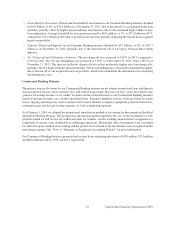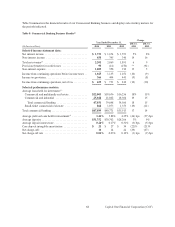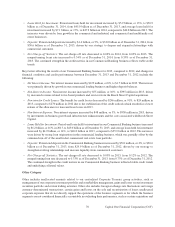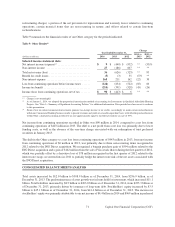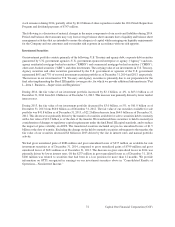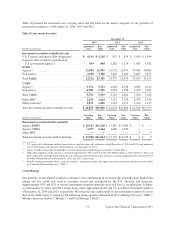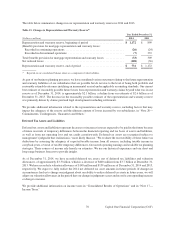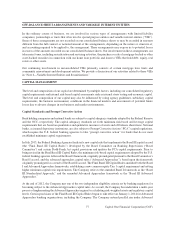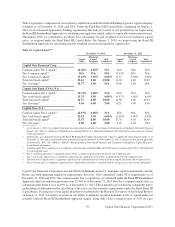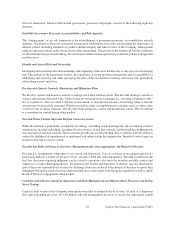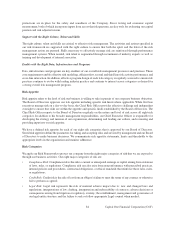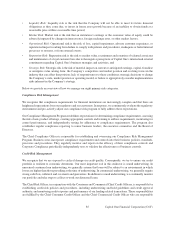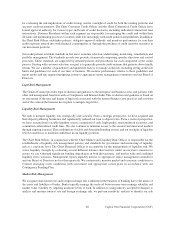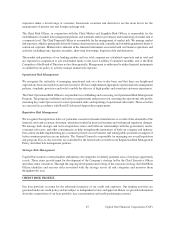Capital One 2014 Annual Report Download - page 99
Download and view the complete annual report
Please find page 99 of the 2014 Capital One annual report below. You can navigate through the pages in the report by either clicking on the pages listed below, or by using the keyword search tool below to find specific information within the annual report.
OFF-BALANCE SHEET ARRANGEMENTS AND VARIABLE INTEREST ENTITIES
In the ordinary course of business, we are involved in various types of arrangements with limited liability
companies, partnerships or trusts that often involve special purpose entities and variable interest entities (“VIE”).
Some of these arrangements are not recorded on our consolidated balance sheets or may be recorded in amounts
different from the full contract or notional amount of the arrangements, depending on the nature or structure of,
and accounting required to be applied to, the arrangement. These arrangements may expose us to potential losses
in excess of the amounts recorded on our consolidated balance sheets. Our involvement in these arrangements can
take many forms, including securitization and servicing activities, the purchase or sale of mortgage-backed or other
asset-backed securities in connection with our home loan portfolio and loans to VIEs that hold debt, equity, real
estate or other assets.
Our continuing involvement in unconsolidated VIEs primarily consists of certain mortgage loan trusts and
community reinvestment and development entities. We provide a discussion of our activities related to these VIEs
in “Note 6—Variable Interest Entities and Securitizations.”
CAPITAL MANAGEMENT
The level and composition of our capital are determined by multiple factors, including our consolidated regulatory
capital requirements and internal risk-based capital assessments such as internal stress testing and economic capital.
The level and composition of our capital may also be influenced by rating agency guidelines, subsidiary capital
requirements, the business environment, conditions in the financial markets and assessments of potential future
losses due to adverse changes in our business and market environments.
Capital Standards and Prompt Corrective Action
Bank holding companies and national banks are subject to capital adequacy standards adopted by the Federal Reserve
and the OCC, respectively. The capital adequacy standards set forth minimum risk-based and leverage capital
requirements that are based on quantitative and qualitative measures of assets and off-balance sheet items. National
banks, as insured depository institutions, are also subject to Prompt Corrective Action (“PCA”) capital regulations,
which require the U.S. federal banking agencies to take “prompt corrective action” for banks that do not meet
established minimum capital requirements.
In July 2013, the Federal Banking Agencies finalized a new capital rule that implements the Basel III capital accord
(the “Final Basel III Capital Rules”) developed by the Basel Committee on Banking Supervision (“Basel
Committee”) and certain Dodd-Frank Act capital provisions and updates the PCA capital requirements. Prior to
being revised in the Final Basel III Capital Rules, the minimum risk-based capital requirements adopted by the U.S.
federal banking agencies followed the Basel I framework, originally promulgated pursuant to the Basel Committee’s
Basel I accord, and the advanced approaches capital rules (“Advanced Approaches”), based upon the framework
originally promulgated as a result of the Basel II accord. The Final Basel III Capital Rules amended both the Basel
I and Advanced Approaches frameworks, establishing a new common equity Tier 1 capital requirement and setting
higher minimum capital ratio requirements. The Company refers to the amended Basel I framework as the “Basel
III Standardized Approach,” and the amended Advanced Approaches framework as the “Basel III Advanced
Approaches.”
At the end of 2012, the Company met one of the two independent eligibility criteria set by banking regulators for
becoming subject to the Advanced Approaches capital rules. As a result, the Company has undertaken a multi-year
process of implementing the Advanced Approaches regime for calculating risk-weighted assets and regulatory capital
levels. Certain provisions of the Final Basel III Capital Rules began to take effect on January 1, 2014 for Advanced
Approaches banking organizations, including the Company. The Company entered parallel run under Advanced
77 Capital One Financial Corporation (COF)


